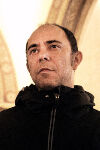Prof. Ravi Deepres’ research has revolutionised contemporary dance practice, by inserting cutting-edge digital technologies into the choreographic process to create novel works for stage, screen, and exhibition.
Research summary
Deepres’ research uses innovative adaptation and implementation of cutting-edge visual and digital technology to create unique artistic representations of the human body in movement.
The research has been central to acclaimed modern dance works, resulting in three main projects including a gallery exhibition, two theatre productions with Studio Wayne McGregor’s, of which reached a staggering combined audience of over 750,000 attendees, and a film for the BBC.
Atomos (2015) was a collaborative project with Studio Wayne McGregor. Research was undertaken in collaboration with LCI Productions, a 3D and event projection company, to find a new way to use 3D imagery on moving screens to combine specially shot film footage with graphic animation.
Woolf Works (2015) was a contemporary dance production made in collaboration with SWM and the Royal Ballet. Here, the research objective was to combine film and dance in a way that referenced Woolf’s experimental use of metaphor and narrative structure to reflect the contemporary social and political climate.
Gain Line (2015)was a film installation commissioned by Rugby Art Gallery (RAG) to celebrate the UK’s hosting of the 2015 Rugby World Cup. The research aim was to explore how the design of the rugby pitch could be adapted for use in a choreographic practice that presented players’ movements in an artistic context, reframing the history and identity of the game of rugby.
Research background
Deepres has collaborated with technology companies such as Google, whose solutions are normally used within the fields of architecture, surveying, and the sciences. These experiments led to the development of novel techniques for applying technologies, such as LIDAR scanning (a 3D mapmaking and surveying technique), 3D projection and super-slow-motion technology to capture live images of the human body. The results of these experiments have been integrated into the choreographic process, resulting in works that combine live dancers with digital and film media.
Outcomes and impact
Deepres’ research has led to an expansion of the boundaries of contemporary choreography, a fact recognised by his nomination for the prestigious ‘Knight of Illumination’ award in 2015.
The research has led to the better understanding and practice of contemporary choreography. During Deepres’ 20-year collaboration with the Studio Wayne McGregor’s lighting teams, set designers and choreographers, his research has introduced novel forms of technology that have redefined the scope of choreography. The main choreographer and director acknowledges that Deepres’ innovative techniques with film and photography have helped the company to explore and create entirely new expressions of choreographic practice. He explains that Deepres’ “vision and ideas have allowed us to use still and moving images in extraordinary ground-breaking new ways, changing the potential of choreography to happen in virtual space and not be limited to the physical body [by showing] both the company and the wider dance world the potential of creating new choreographic languages through technology.”
The research has also led to the creation of new commissioning opportunities. The artistic administrator of the National Ballet of Canada (NBC) acknowledged that: “Mr. Deepres’ work as film designer…specifically on Woolf Works…is a key ingredient and integral component of the commission…” of a major new co-production between NBC and the Royal Ballet, scheduled for 2022. After working on Gain Line, the directors of Film & Video Umbrella (FVU) commissioned a new work from an emerging artist that also used LIDAR technology (2017). The FVU technical manager acknowledges “a definite connection between working with Ravi, working with that particular [LIDAR] technology, seeing what it could do, and then introducing that to another artist.”
By challenging conventional understandings of choreography, via the novel application of visual technologies, he has provoked significant changes in the practice of both his immediate collaborators and of those further afield.


